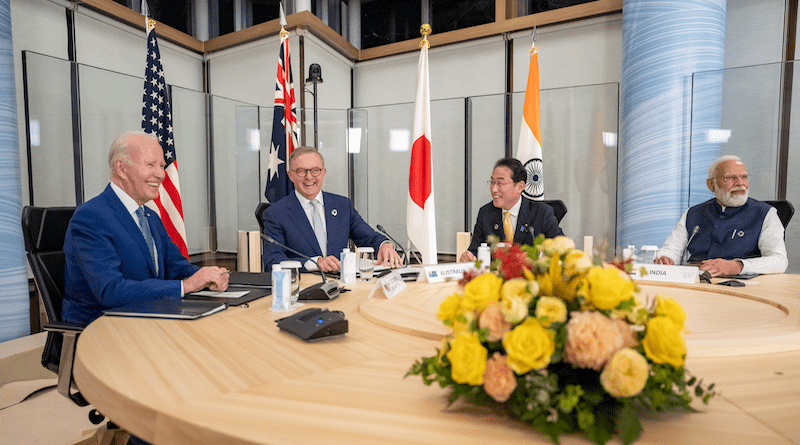The Quad Is Rebalancing – Analysis
By Observer Research Foundation
By Vivek Mishra*
The Quad Summit, held this month, brought together the leaders of Australia, India, Japan, and the United States once again to review progress and commit to developments. The meeting was held on the sidelines of the G7 Summit in Japan instead of being held in Australia, as planned earlier. Yet, the group managed to bring out the Quad leaders’ Vision Statement and Joint Statement, promising expanded commitments and announcing new mechanisms to facilitate cooperation in the Indo-Pacific region.
The Quad is deftly rebalancing itself as a group with core security interests in the Indo-Pacific without specifically outlining such intentions, even as non-traditional security concerns have been deftly woven with the security compulsions of the region. At the heart of this recalibration lies a twin focus on institutional mechanisms and a technology-oriented approach, which is likely to keep the Quad poised to meet both traditional and non-traditional security concerns in the Indo-Pacific region.
The latest summit focused on the member countries’ collective efforts to promote peace, security, and prosperity in the Indo-Pacific region by underscoring a tripartite institutional linkage between the Association of Southeast Asian Nations (ASEAN), the Pacific Islands Forum (PIF), and the Indian Ocean Rim Association (IORA). Not only does this highlight the importance of regional institutions and frameworks as the preferred way of operating for the members, but it also pegs three important domains of focus for the Quad: the South China Sea, the South Pacific, and the Indian Ocean region. Over the long term, the Quad is likely to link the three subregions across its widening focus arc, including climate action, clean energy, infrastructure development, and maritime security—all aided by technology.
The categorization of its focus across three institutional mechanisms also highlights the grooming of the Indo-Pacific as a democratic space with shared respect for regional leadership. It also points to a strategic threat continuum spanning from the Pacific to the Indian Ocean. Individually, the three subregions’ importance to the regional balance in the Indo-Pacific cannot be overstated. The Joint Statement’s emphasis on the implementation of the ASEAN Outlook on the Indo-Pacific (AOIP) depicts Quad’s aim to complement ASEAN’s regional leadership role. In the same breath, it also acknowledged the significance of ASEAN’s forums, such as the East Asia Summit and the ASEAN Regional Forum, as crucial platforms for strategic dialogue and cooperation in the region, the latter being a critical platform for security dialogue in the Indo-Pacific.
The Pacific theatre is now an obvious area of interest to boost non-traditional activities by the Quad countries. In this regard, two important meetings that closely followed the Quad meeting were the third Summit of the Forum for India-Pacific Islands Cooperation and the US-Pacific Island Forum meeting. The Quad countries’ engagement with the region would aspire to strike a balance between addressing the immediate and core security interests of countries like Australia and Japan apropos China and supporting regionally inclusive objectives outlined in the “2050 Strategy for the Blue Pacific Continent,” which was launched to deal with challenges such as climate change-related impacts together with the intensification of geostrategic competition.
Infrastructure development in the Indo-Pacific finds itself as a core Quad purpose and feeds into other objectives such as regional connectivity and economic growth for all four countries. In this regard, the announcement of the “Quad Infrastructure Fellowships Programme” is aimed at boosting infrastructure expertise across the Indo-Pacific. Furthermore, the centrality of undersea cable networks has been firmly underscored by the Quad Partnership for Cable Connectivity and Resilience, which aims to strengthen the resilience and security of critical communication infrastructure in the region.
Other initiatives during the Summit include the need to facilitate investments in strategic technologies, including clean energy, semiconductors, critical minerals, and quantum; the launch of the Clean Energy Supply Chains initiative designed to accelerate the region’s transition to clean energy; and commitment to the Indo-Pacific Partnership for Maritime Domain Awareness (IPMDA), which was announced during the 2022 Tokyo Quad Leaders’ Summit. Specifically, the IPMDA intends to enhance maritime surveillance, information sharing, and cooperation to ensure a safe and secure maritime environment.
Finally, the broadening of the vaccine partnership between Quad countries during the Covid-19 pandemic into a wider Quad Health Security Partnership, focusing on strengthening health security in the Indo-Pacific region, reflects a regional health security approach.
The recent meeting of senior military commanders from Quad countries in California signalled a rebalancing that may well be underway within the Quad.
About the author: Vivek Mishra is a Fellow with ORF’s Strategic Studies Programme. His research interests include America in the Indian Ocean and Indo-Pacific and Asia-Pacific regions, particularly the role of the US in security in South Asia, Indo-US defence relations, and the Indian defence sector
Source: This article was published by Observer Research Foundation and originally appeared in Deccan Herald.

